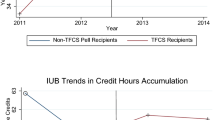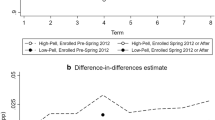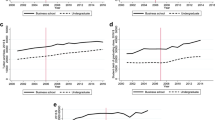Abstract
The Federal Pell Grant Program is the nation’s largest need-based grant program. While students’ initial eligibility for the Pell is based on financial need, renewal is contingent on meeting minimum academic standards similar to those in models of performance-based scholarships, including a grade point average (GPA) requirement and ratio of credits completed compared to those attempted. In this study, we describe federal satisfactory academic progress (SAP) requirements and illustrate the policy’s implementation in a statewide community college system. Using state administrative data, we demonstrate that a substantial portion of Pell recipients are at risk for Pell ineligibility due to their failure to meet SAP GPA or credit completion requirements. We then leverage the GPA component of the policy to explore the impacts of failure to meet standards on early college persistence and achievement, earning a credential, and transferring to a 4-year college using two methodological approaches: regression discontinuity (RD) and difference-in-differences (DD). Our results across the two approaches are mixed, with the RD providing null estimates and the DD indicating statistically significant impacts, including a negative effect on early college persistence. We conclude by discussing the implications for future research.





Similar content being viewed by others
References
Altonji, J. G. (1993). The demand for and return to education when education outcomes are uncertain. Journal of Labor Economics, 11, 48–83.
Angrist, J., Autor, D., Huson, S., & Pallais, A. (2014). Leveling up: Results from a randomized evaluation of post-secondary aid. (NBER Working Paper No. 20800). Cambridge, MA: National Bureau of Economic Research.
Attewell, P., Heil, S., & Reisel, L. (2011). Competing explanations of undergraduate noncompletion. American Educational Research Journal, 48(3), 536–559.
Barreca, A. I., Guldi, M., Lindo, J. M., & Waddell, G. R. (2011a). Saving babies? Revisiting the effect of very low birth weight classification. Quarterly Journal of Economics, 126(4), 2117–2123.
Barreca, A. I., Lindo, J. M., & Waddell, G. R. (2011). Heaping-induced bias in regression-discontinuity designs. (NBER Working Paper No. 17408). Cambridge, MA: National Bureau of Economic Research.
Barrow, L., Richburg-Hayes, L., Rouse, C. E., & Brock, T. (2014). Paying for performance: The education impacts of a community college scholarship program for low-income adults. Journal of Labor Economics, 32(3), 563–599.
Baum, S., & Payea, K. (with Kurose, C.). (2013). Trends in student aid 2013. Retrieved from the College Board website: http://trends.collegeboard.org/sites/default/files/student-aid-2013-full-report-140108.pdf.
Bénabou, R., & Tirole, J. (2002). Self-confidence and personal motivation. Quarterly Journal of Economics, 117(3), 871–915.
Bennett, W., & Grothe, B. (1982). Implementation of an academic progress policy at a public urban university: A review after four years. Journal of Student Financial Aid, 12(1), 33–39.
Bettinger, E. (2004). How financial aid affects persistence. In C. M. Hoxby (Ed.), College choices: The economics of where to go, when to go, and how to pay for it (pp. 207–238). Chicago: University of Chicago Press.
Bettinger, E., Long, B. T., Oreopoulos, P., & Sanbonmatsu, L. (2012). The role of application assistance and information in college decisions: Results from the H&R block FAFSA experiment. Quarterly Journal of Economics, 127(3), 1205–1242.
Calonico, S., Cattaneo, M. D., & Titiunik, R. (2014a). Robust data-driven inference in the regression-discontinuity design. Stata Journal, 14(4), 909–946.
Calonico, S., Cattaneo, M. D., & Titiunik, R. (2014b). Robust nonparametric confidence intervals for regression-discontinuity designs. Econometrica, 82(6), 2295–2326.
Carruthers, C. K., & Ozek, U. (2013, February). Losing HOPE: Financial aid and the line between college and work. National Center for Analysis of Longitudinal Data in Education Research Working Paper 91.
Casey, M., Cline, J., Ost, B., & Qureshi, J. (2015, February). Academic probation, student performance and strategic behavior. Paper presented at the annual meeting for the Association for Education Finance and Policy, Washington, DC.
Castleman, B., & Long, B. T. (2013). Looking beyond enrollment: The causal effect of need-based grants on college access, persistence, and graduation (NBER Working Paper No. 19306). Cambridge, MA: National Bureau of Economic Research.
Cohodes, S. R., & Goodman, J. S. (2014). Merit aid, college quality, and college completion: Massachusetts’ Adams Scholarship as an in-kind subsidy. American Economic Journal: Applied Economics, 6(4), 251–285.
Cornwell, C. M., Lee, K. H., & Mustard, D. B. (2005). Student responses to merit scholarship retention rules. Journal of Human Resources, 40, 895–917.
Cornwell, C., Mustard, D. B., & Sridhar, D. J. (2006). The Enrollment Effects of Merit-Based Financial Aid: Evidence from Georgia’s HOPE Program. Journal of Labor Economics, 24(4), 761–786.
Denning, J. (2014, December). College on the cheap: Costs and benefits of community college. University of Texas: Working paper.
Dynarski, S. M. (2003). Does aid matter? Measuring the effect of student aid on college attendance and completion. American Economic Review, 93(1), 279–288.
Dynarski, S. M. (2008). Building the stock of college-educated labor. Journal of Human Resources, 43(3), 577–610.
Goldrick-Rab, S. (2013). Increasing the impact of student financial aid: Three recommendations for financial aid administrators. Washington, DC: HCM Strategists.
Goldrick-Rab, S., Kelchen, R., Harris, D., & Benson, J. (Forthcoming). Reducing income inequality in higher education: Experimental evidence on the impact of financial aid on college completion. American Journal of Sociology.
Hahn, J., Todd, P., & Van der Klaauw, W. (2001). Identification and estimation of treatment effects with a regression-discontinuity design. Econometrica, 69(1), 201–209.
Henry, G. T., Rubenstein, R., & Bugler, D. T. (2004). Is HOPE enough? Impacts of receiving and losing merit-based financial aid. Educational Policy, 18(5), 686–709.
Imbens, G. W., & Kalyanaraman, K. (2012). Optimal bandwidth choice for the regression discontinuity estimator. Review of Economic Studies, 79(3), 933–959.
Imbens, G. W., & Lemieux, T. (2008). Regression discontinuity designs: A guide to practice. Journal of Econometrics, 142(2), 615–635.
Kane, T. J. (1995, July). Rising public college tuition and college entry: How well do public subsidies promote access to college? (NBER Working Paper No. 5164). Cambridge, MA: National Bureau of Economic Research.
Lindo, J. M., Sanders, N. J., & Oreopoulos, P. (2010). Ability, gender, and performance standards: Evidence from academic probation. American Economic Journal: Applied Economics, 2(2), 95–117.
Manski, C. F. (1989). Schooling as experimentation: A reappraisal of the postsecondary dropout phenomenon. Economics of Education Review, 8(4), 305–312.
Martorell, P., McCall, B. P., & McFarlin, I. (2014, September). Do public tuition subsidies promote college enrollment? Evidence from community college taxing districts in Texas. US Census Bureau Center for Economic Studies Paper No. CES-WP-14-32.
Mayer, A. K., Patel, R., Rudd, T., & Ratledge, A. (with Blake, S.). (2015). Designing scholarships to improve college success: Final report on the Performance-based scholarship demonstration. New York: MDRC.
McCrary, J. (2008). Manipulation of the running variable in the regression discontinuity design: A density test. Journal of Econometrics, 142(2), 698–714.
McNair, E., & Taylor, S. E. (1988). Satisfactory academic progress standards: Jeopardizing efforts toward educational equity? Journal of Student Financial Aid, 18(1), 10–17.
Richburg-Hayes, L., Brock, T., LeBlanc, A., Paxson, C., Rouse, C. E., & Barrow, L. (2009). Rewarding persistence: Effects of a performance-based scholarship program for low-income parents. New York: MDRC.
Satisfactory Academic Progress, 34 C.F.R. § 668.34. (2013). Electronic Code of Federal Regulations. Retrieved from http://www.ecfr.gov/cgi-bin/text-idx?c=ecfr&tpl=/ecfrbrowse/Title34/34cfr668_main_02.tpl.
Scott-Clayton, J. (2011). On money and motivation: A quasi-experimental analysis of financial incentives for college achievement. Journal of Human Resources, 46(3), 614–646.
Scott-Clayton, J. (2013). Information constraints and financial aid policy. In D. E. Heller & C. Callender (Eds.), Student financing of higher education: A comparative perspective (pp. 75–97). New York, NY: Routledge.
Student Eligibility, 20 u.s.c. 1091 H.E.A. § 484. (2013). Retrieved from http://www.house.gov/legcoun/Comps/HEA65_CMD.pdf.
U.S. Census Bureau. (2014). Median household income (in 2013 inflation-adjusted dollars) by state ranked from highest to lowest using 3-year averages. Retrieved from http://www.census.gov/hhes/www/income/data/statemedian/.
U.S. Census Bureau. (2007). Small Area income and poverty estimates: state and county estimates for 2007. Retrieved from https://www.census.gov/did/www/saipe/data/statecounty/data/2007.html.
U.S. Department of Education, National Center for Education Statistics. (2013). Digest of education statistics, 2012 (NCES 2014-015), Chapter 3, Table 381. Retrieved from http://nces.ed.gov/programs/digest/d12/tables/dt12_381.asp.
Welbeck, R., Ware, M., Cerna, O., & Valenzuela, I. (with Ratledge, A., & Boynton, M.). (2014). Paying it forward: A technical assistance guide for developing and implementing performance-based scholarships. New York: MDRC.
Whitehouse.gov. (2015). Fact sheet—White House unveils America’s college promise proposal: Tuition-free community college for responsible students. Retrieved from: https://www.whitehouse.gov/the-press-office/2015/01/09/fact-sheet-white-house-unveils-america-s-college-promise-proposal-tuitio.
Acknowledgments
The research reported here was supported by the Institute of Education Sciences, U.S. Department of Education, through Grant R305C110011 to Teachers College, Columbia University. The opinions expressed are those of the authors and do not represent views of the Institute or the U.S. Department of Education.
Author information
Authors and Affiliations
Corresponding author
Electronic supplementary material
Below is the link to the electronic supplementary material.
Rights and permissions
About this article
Cite this article
Schudde, L., Scott-Clayton, J. Pell Grants as Performance-Based Scholarships? An Examination of Satisfactory Academic Progress Requirements in the Nation’s Largest Need-Based Aid Program. Res High Educ 57, 943–967 (2016). https://doi.org/10.1007/s11162-016-9413-3
Received:
Published:
Issue Date:
DOI: https://doi.org/10.1007/s11162-016-9413-3




